There are many resources that explain the differences between the various types of RVs including our Beginers Guide to RVs, but if you are on our site you have probably already decided on a Luxury RV. Before we bought our first motorhome, we did a lot of research. Here are the 20 things we answered before Buying An RV.
How to Avoid an Expensive Mistake When Buying An RV
20 Questions to Answer BEFORE You Buy Your Class A RV
There are as many unique RV brands, models and layouts as there are different people. In this post, we reveal the top 20 questions you should answer before you decide which motorhome to buy.
Plus, in the end, we offer 8 additional insider tips to help you buy an RV.
1.) Buying An RV– What are RV Slides (or Slide Outs) and do I need them?
All roads have restrictions that require vehicles to be no wider than about 8 feet. This makes for small living quarters (about 320 square feet in a 40-foot RV) and limited amenities.
In 1990, the Newmar Corporation, one of the leading RV manufacturers solved this limited space problem by inventing the first luxury Class A RVs with power slide-outs.
RV Slides are literally RV room extensions that slide out of either side of the motorhome when it is parked. They can be on one or both sides of an RV and generally add about an extra 3 feet to each side of the motorhome.
Instead of an interior living space of only eight feet wide, once the slides are open you now have a 14-foot wide living area inside the RV! It may not sound like much, but it can add almost an extra 100 square feet to the interior of the RV.
Compare the various motorhomes you are considering and ask to see them with the slides in and with the slides out. Once you decide how many slides you want you can narrow down your choices to those RV models that have the right number of slides.
Our Newmar Mountain Aire has 3 slides, one down each side and one in the master bedroom suite in the back.
2.) Buying An RV– How many people can sleep in a Class A RV? Do RVs have bedrooms?
Class A RVs can sleep 2-7 people depending on the model and size of the motorhome. Some offer up to two bedrooms, and others have convertible sleeping areas that perform double duty as storage when not being used for sleeping.
3.) Buying An RV– What Kinds of Beds are in a Class A RV?
Class A RVs have a master suite that offers either king or queen-sized beds. Our Newmar Class A RV has a king-sized Sleep Number™ mattress.
Many RV couches are sleeper sofas with superior inflatable mattresses that are quite comfortable and can easily accommodate the occasional guest.
There are about 5 Class A RV manufacturers that offer the option of bunk beds or loft beds. Sometimes referred to as bunkhouse layouts, the advantage of these layouts is that when you are not using them for sleeping accommodations they can easily be converted into additional storage.
4.) Buying An RV– How many beds do you really need in your RV?
This is really one of the most important questions that you need to answer first. Will you be traveling as a couple or with family? Be very realistic on this one.
Don’t make the mistake of thinking that you need more accommodations for people that don’t live and travel full time with you. The easy and less expensive answer is, instead of purchasing a motorhome with extra sleeping space that will only be used occasionally, choose one with extra storage and living space.
Have guests stay at nearby hotels
One option is to consider having guests stay at nearby hotels. We’re speaking from experience, it’s much cheaper to pay for the occasional hotel stay and have the usable living space than it is to have wasted sleeping quarters.
Inflatable Mattresses provide a great solution
Another option for sleeping arrangements that work well in motorhomes for short term guests is inflatable mattresses. There have been many improvements in the design and comfort of inflatable mattresses in recent years.
Air mattresses are now made in tall heights of almost 2 feet, which makes getting in and out of them much easier. Just like regular mattresses, they are available in different sizes. The better-quality inflatable mattresses are made of heavy-duty materials so they don’t deflate in the night and pets can’t puncture them easily. Plus, now they come with built-in self-inflating pumps, so they are quick and easy to set up. With the limited amount of storage space in RVs, this a great choice.
We purchased one of the newest inflatable queen mattresses that we use for guests called the Englander. It’s a high-quality air mattress that costs just over $125. It’s tall (20”) and has a microfiber cover so it’s not cold to sleep on and uses regular sheets. Best of all it inflates in about 2 minutes, comes with its’ own storage bag and is incredibly comfortable. If you want to see the one we purchased and recommend, click this link to go see it on Amazon.
5.) Buying An RV– Which Class A RV manufacturers offer bunk beds? (Not interested in bunk beds in your RV? Skip this section)
If you need bunk beds in your RV for kids or grandkids, you do have at least 5 different RV manufacturers and several different floor plans to choose from. Bunk bed options change from year to year and can vary by model. Contact your local motorhome dealer to learn what pre-owned models may be available that also offer bunk beds.
Read on to take a look at the current model year Class A RV’s with bunk beds.
Winnebago
The Winnebago Forza line offers two models with bunk or loft beds. If you want more information, here’s the link to visit Winnebago’s website.
Winnebago Forza 38F
Winnebago’s Forza 38F has a layout with a StudioLoft™ bed above the driver and passenger seat with a base price of around $260,000. Here’s the floor plan courtesy of Winnebago’s website:
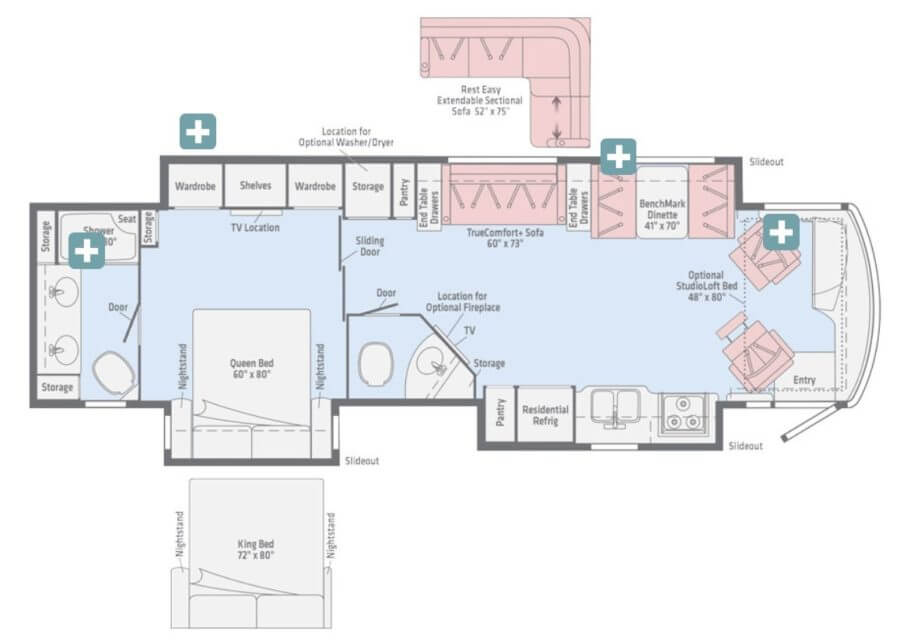
Winnebago Forza 38W
Winnebago Forza 38W not only offers the StudioLoft™ bed and a Bunk Bed layout, but this model has two full baths to accommodate the extra passengers. Base price begins at $270,000. Here’s the floor plan courtesy of Winnebago’s website:
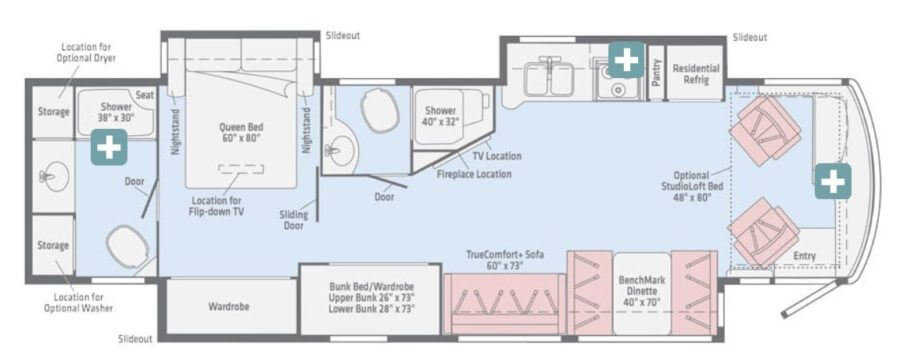
Tiffin Motorhomes
Known to be a little more luxurious, a top motorhome manufacturer that offers a bunk bed layout is Tiffin. If you want more information, here’s the link to visit Tiffin’s website.
Tiffin Open Road 36 UA
Offering bunk beds and an optional front bunk, the Open Road is a gas Class A and has a base price of around $200,000. Here’s the floor plan courtesy of Tiffin’s website:
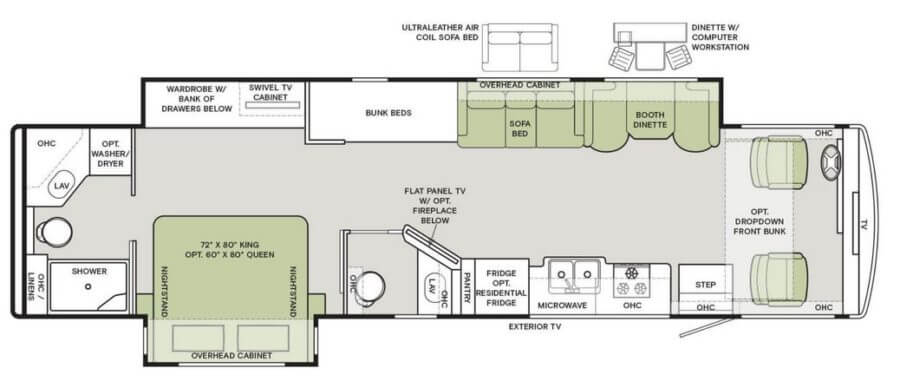
Fleetwood
Fleetwood also currently offers two models with bunk beds. If you want more information, here’s the link to visit Fleetwood’s website.
Fleetwood Discovery LXE 40G
The LXE has a base price of $360,000. Floor plan courtesy of Fleetwood’s website:
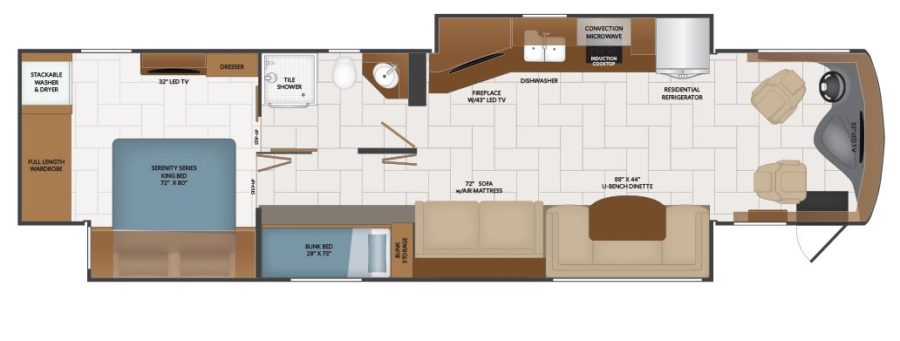
Fleetwood Discovery 38N
The 38N has a base price of $330,000. Floor plan courtesy of Fleetwood’s website:
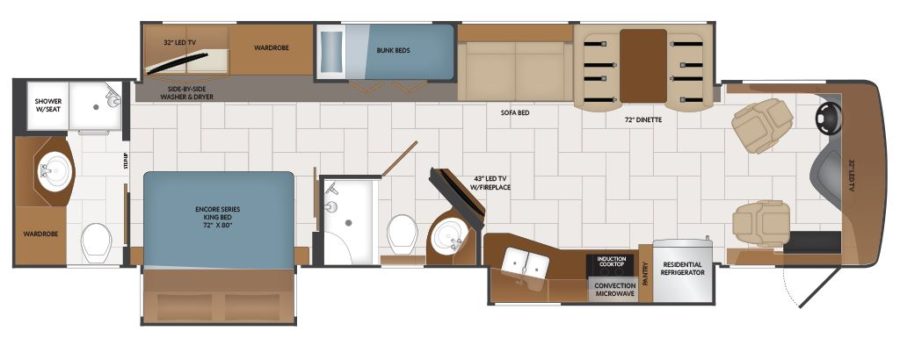
Holiday Rambler
Has two current models with bunk beds. Here’s a link to Holiday Rambler’s site for more information.
Holiday Rambler Navigator 38N
A 38-foot Class A RV with a base price of $305,000. Floor plan courtesy of Holiday Rambler’s website:
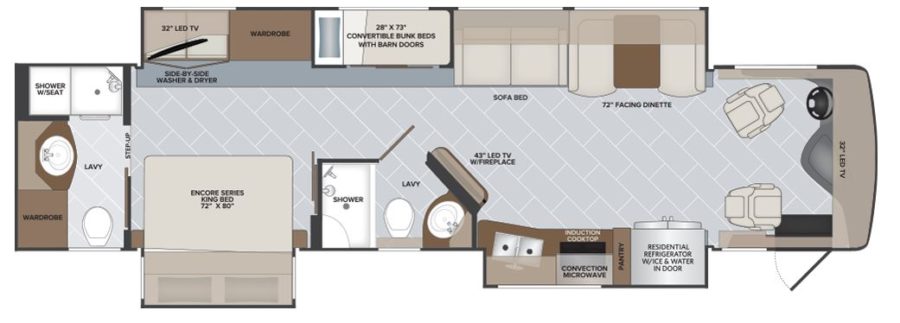
Holiday Rambler Vacationer 36FP
This is a gas-powered Class A RV with a base price of $180,000. One cool feature of this model is the fold-down patio in the back! Floor plan courtesy of Holiday Rambler’s website:

6.) Buying An RV– How long do you plan on staying in your RV at a time?
The next major question you should answer is, how long do you plan on spending in your RV at a time? Will you take short trips, or long extended ones or do you plan on living in your RV?
The answer will seriously impact your choice in RVs and can change over time. If you are taking short trips and are not planning on spending long periods in your RV until retirement, then you might find that a smaller one will work better now. You can always upgrade later and you will get the experience to help you decide what size and features will be important to you.
We started with a 34-foot Tiffin and learned the basics of RVing. We decided that we liked it so much that we upgraded to a 44-foot Newmar and went full time!
7.) Buying An RV– Where will you park your motorhome when you are not using it?
No matter how much time you plan on spending in your RV, you are going to need to plan a place to park it.
If you are the occasional RV traveler and still own your home, does your community allow you to park it on your property, or are there rules against it? Does your community offer a discounted storage lot for recreational vehicles? Generally, that’s the least expensive and best alternative.
If a community RV storage space is not available to you, you will need to search out a storage yard or facility. Depending on the climate where you live, you might want to investigate indoor climate-controlled storage if your RV sits idle through the tough winter months. Often these spaces are limited and can be costly, so plan on booking in advance.
8.) Buying An RV– Do you need to plan ahead for RV Sites?
Yes, if you are planning on long term or full-time travel in your motorhome, this too will require advance planning. If you want to spend the winter in the south (or chasing the sun as many RV’ers call it!), you will need to plan well in advance. Some of the premium RV parks can book up as much as a year in advance! Plan well, otherwise, you might find very limited options or have to sit out the season.
We generally stay in RV resorts and if we like a particular park, we reserve our next visit right then even if it’s a year in advance! It normally requires a small deposit and if you cancel in advance, they will often refund most of your deposit. That’s one way to guarantee a spot is available for your next trip and takes the stress out of searching for an available site.
9.) Buying An RV– Who is going to drive your RV and what features do they prefer?
Now that you have an idea of how big of an RV you want, how you are going to use it and where you are going to keep it, the next step is to decide how… or who is going to drive?
Are you and your companion both going to drive it, or will one of you be the driver and the other the navigator? The reason this is so important at this stage is that the driver or drivers need to be comfortable behind the wheel.
We’ve heard stories of couples who have taken delivery of a new coach, driven home and were so afraid of it they never drove it again! Great deal for next buyer, not so for the original owner!
Tip:
Consider an RV Driving School
If this is your first RV and you have never driven a large vehicle before or towed anything like a boat or trailer, maybe you should consider an RV driving school. Most coach manufacturers will have access to driving schools or they can be easily found in your area on an internet search or at any RV show.
Another reason to consider RV driving school is that sometimes your partner doesn’t always make the best teacher! The tips and tricks you learn in a controlled setting with a calm and competent instructor will be invaluable if you are ever in an emergency situation while driving your RV. Also, they will teach you how to identify and learn your RV height and width clearances to avoid damage to the exterior of your motorhome.
10.) Buying An RV– How Many Axles Do You Want on Your RV?
Class A RVs can have two or three axles depending on the size of the RV. The third axle is also called a tag axle and can have one or two tires on each side. Tag axle motorhomes have more carrying capacity, more stability in crosswinds, and better ride quality than a two-axle RV.
Want to learn more about tag axle RVs, I wrote a detailed post explaining the differences here.
11.) Buying An RV– Do you plan on towing a car behind your RV?
If you are planning on towing a car behind your RV, you should know that not all cars can be towed. It depends on the make, model and year of the car.
It’s very important to know how much your RV is capable of towing before you decide on a tow vehicle.
If you exceed the towing capacity of your RV and have an accident- whether the accident is your fault or not, you may be held liable!
Also, don’t forget to consider where you will be towing your car. Towing in the mountains requires a more powerful RV than towing in flat terrain.
Some cars can be towed with all 4 wheels on the ground (also called flat towing). For safety, you should add a supplementary braking assist system like the Blue Ox or the Roadmaster to the towed vehicle.
Other cars require that you place the front wheels on a dolly or a towing trailer to avoid damaging the transmission system.
If you want to learn more about towing a car behind your RV, I wrote a detailed post explaining them, click here to read it.
How to find out if your car can be towed
The best way to find out if your car can be towed is by checking the towing specifications and restrictions in your owner’s manual or contacting your vehicle manufacturer.
Do not rely on a car salesman or auto dealership to know this answer. We met one gentleman who bought a brand-new pickup truck that the dealer said was towable. After he purchased the towing equipment, the tow equipment installer notified him that the truck could not be towed and it would void his new car warranty by doing so!
Another very reliable source on vehicle towing is published in cooperation with vehicle manufacturers by Motorhome Magazine every year. You can check new and used vehicle’s towing requirements based on car year and model. Go to their website and download their car towing list, but I would also verify towing specifications in your car manual to make sure you don’t void your warranty.
12.) Buying An RV– Make a list of Must-Haves BEFORE you go RV Shopping!
Before you go RV shopping, create a list of what things you must have on your motorhome and which are nice to have.
Here are a few ideas to consider when making your RV shopping must-have list:
13.) Buying An RV– Where do you plan to travel?
RVs are not insulated like homes are. If you will be spending time in the hotter climates, you will need big enough air conditioners that can keep you cool. If you plan on traveling in colder climates, an important option to have are heated water bays to keep your plumbing from freezing. You might also consider heated floors and an indoor fireplace (yes, some RVs do have fireplaces inside!).
14.) Buying An RV– Will you spend most of your time in RV parks or at remote locations?
If you plan on spending most of your time in RV parks, electric, water, and waste disposal services are normally available. If you prefer remote locations, you may need solar panels for power, larger water, and waste tanks for an extended time in between emptying and refilling, and propane tanks for cooking and heat.
15.) Buying An RV–Do you have any special storage needs for your RV?
Do you have expensive bikes, a golf cart, or motorcycles that you plan on bringing with you? Storage requirements will narrow down the choices in RVs. Some RV’ers use their motorhomes to travel to locations where they enjoy hobbies like craft fairs or dog shows. Consider what type of storage you may need for the things you will want to bring with you, and don’t forget to plan for hobby items like sewing machines, trade-show supplies or even dog kennels.
Learn more about how to bring your motorcycles or bikes in our article RV Lift Systems.
16.) Buying An RV– Does the RV floor plan and layout accommodate your lifestyle?
If one of you is an early riser or late sleeper, do you need a floor plan that lets you close your bedroom off and not walk through it from the living area? Do you have to go through the bedroom to get to the bath?
17.) Buying An RV– What size bed do you need in your RV?
Do you want a walk-around bed so you don’t have to climb over your partner to get in and out? Do you need a special mattress like a sleep number, or want one that elevates to allow you to sit up?
18.) Buying An RV– Do you have medical equipment requirements?
If you use a CPAP machine, make sure there’s an outlet and place to safely set it so it doesn’t fall on you at night. Don’t forget storage space for any medical equipment.
19.) Buying An RV– How many bathrooms do you need in your RV?
You can get one, one and a half and even two-bathroom layouts. Some RVs offer split bath layouts, double sinks and allow you to add options like bidets and tankless water heaters so you will always have plenty of hot water.
Get in the shower of the RVs you like and see if you can comfortably fit!
20.) Buying An RV– What appliances do you want in your RV?
RVs can come equipped with practically every appliance that is in a home. The only difference is that you need to make sure that you have enough power to supply to them because adding them later can get expensive or be very difficult.
RV Appliances- Advice and Selection Tips on why we picked what we did
In addition to air conditioners and heaters, here are a few other appliances and options to consider for your RV:
- Washer and Dryer- a stackable (our choice) or all in one unit. Due to space consideration, it’s difficult to change them from an all one to a stackable, so make sure you give this one a lot of thought!
- Dishwasher- We prefer real dishes (not paper plates) and entertain often, so I use my RV dishwasher almost every day. Other people say they use their dishwashers for storage. Our first RV did not have a dishwasher, so after living without it for a while this became a must-have appliance for me.
- Propane, Electric, or Induction Cooktop- I chose an Induction cooktop because I cook often, and it doesn’t heat up the inside of the RV so quickly. I also feel it’s safer than propane gas cooking inside the RV. This is another option that can be expensive or impossible to change, especially if you want to go from electric to propane and your RV doesn’t already have the propane lines.
- Full Oven- if you bake often you may decide that you want a regular oven instead of the standard microwave convection oven normally found in RVs. I don’t bake often, so I decided the microwave convection oven would be fine for me.
- Residential Refrigerator and Freezer- In the larger RVs, you can have a full-size residential refrigerator just like in a house. We absolutely required a residential fridge in our RV, and if you plan on taking extended trips in your motorhome it is an important feature to have.
- RV Central Vacuum Systems- This is a great option that we picked, and it eliminates the need for storage space for a regular vacuum.
- RV On Demand Water Heater- Also another great option that we picked. It’s great to have nice long hot showers and never run out of hot water. We have an AquaHot on our coach.
Be careful when in remote locations, you can fill your gray water tanks quickly enjoying these long, hot showers!
- Solar panels – If you plan on spending a lot of time in remote locations, this might be a great option to add to your list. On the other hand, if you like us and spend most of the time in RV resorts with full hookups, it might be a waste of money.
Final Tips on Selecting Your RV
1.) Try renting an RV before you buy.
It’s a great way to learn which features you like. I interviewed a couple that
rented before they bought, you can read more about that and get the link to a
highly recommended luxury RV rental company here.
2.) Visit an RV show and try to pretend to live in the model you have in mind
Sit in the driver’s seat and see if you find comfortable. Imagine what it would be like to cook in the kitchen and whether you have enough room. Get in the shower, is it tall enough and big enough? Do you like a dining booth or a table and chairs? Make sure you sit in both and see if there’s enough room.
3.) Ask to see the Slides in and out
Have them close the slides. Can you move around comfortably and get to the bathroom when they are closed?
4.) Is there enough Storage- Inside and Out?
How much storage is there inside? Does outdoor storage offer easy access? Do the basement doors stay open themselves? It’s hard to hold them open and load things in them. Are they tall and wide enough to fit what you need? Are there slide-out drawers?
5.) Expand Your Search- Take Advantage of the Fly and Buy Programs
Once you decide what RV model you want, don’t limit your search to buying locally. Try searching RV Trader online for your specific model and when you find a dealer that has the RV that you want, ask about dealer incentives and travel reimbursements if you buy from them.
Many of the larger RV dealerships offer a “Fly and Buy” program where they will buy you a plane ticket to fly out and test drive the RVs they have available. Once you purchase, you can get the fun experience of driving your new RV home.
6.) Buy in the Winter and Negotiate!
The best time to buy an RV begins in October through winter. This is because RV dealers don’t want them sitting on their lots through the winter when most people are not using their RVs. RVs need to be winterized in colder climates and sellers (both dealers and private sellers) don’t want to incur the extra costs associated with winterizing.
Don’t be afraid to negotiate whether it’s a dealer or private seller. If it’s a dealership, ask about financing incentives and any other rebates they may offer. Also, consider buying a prior model year if available. You might also find that they can offer free storage until you are ready to take delivery.
7.) Join Facebook Owners Groups
Go to the Facebook owners groups for the makes of RV you like and ask actual owners what they love and hate about their RV. Don’t forget though, some people just like to complain. I would suggest that unless you see a specific problem that many owners are complaining about, I wouldn’t believe every criticism.
RVs have many systems and most are pretty complex, so there are bound to be issues. If the manufacturer or dealership resolves repair issues quickly, then it might not be that big of an issue after all. I would be concerned is if I saw a pattern of issues that the manufacturer wasn’t fixing.
If their Customer Service is unresponsive to owners, that tells me to look for other manufacturers. Both our Newmar and our Tiffin have excellent Customer Service technicians that have been able to answer every question we have had- quickly and professionally.
8.) Last and Most Important- Consider hiring an RV Inspector for a Pre-purchase Inspection
Hiring a National Recreational Vehicle Inspectors Association (NRVIA) certified RV inspector only costs around $700-$1000 and can save you thousands and eliminate a lot of aggravation down the road. RV inspectors know the many systems on an RV and which makes and models are prone to problems with them.
Plus, certified RV inspectors have the tools to test for issues like lot rot, which is water damage from sealant leaks from sitting on lots for too long (if a moisture meter registers 20%, then it means the RV needs repair). They can also help you estimate what ongoing maintenance costs are (which you should always factor into your budget). RV inspectors will also know the names of good RV repair shops as it can often take a while to get a repair done and good repair places hard to find.
You can search for an inspector by clicking here to go to their website: NRVIA
That’s our 28 ways to avoid an RV Buying Mistake.
Good Luck in your search for your perfect Class A RV!
Related Questions People Also Ask About Buying An RV
Can you buy an RV with no money down?
Yes, you can buy an RV with no money down if you have excellent credit and a solid financial statement. However, you might end up owing more than the RV is worth when you want to sell it because RVs depreciate about 25% in the first year alone.
How old of an RV can you finance?
Most lenders will not finance RVs older than 10 years. There are a few that will finance some RVs for 15 years if they are in excellent condition with low mileage and you have excellent credit.
Featured Image provided by Sharon McCutcheon on Unsplash.
